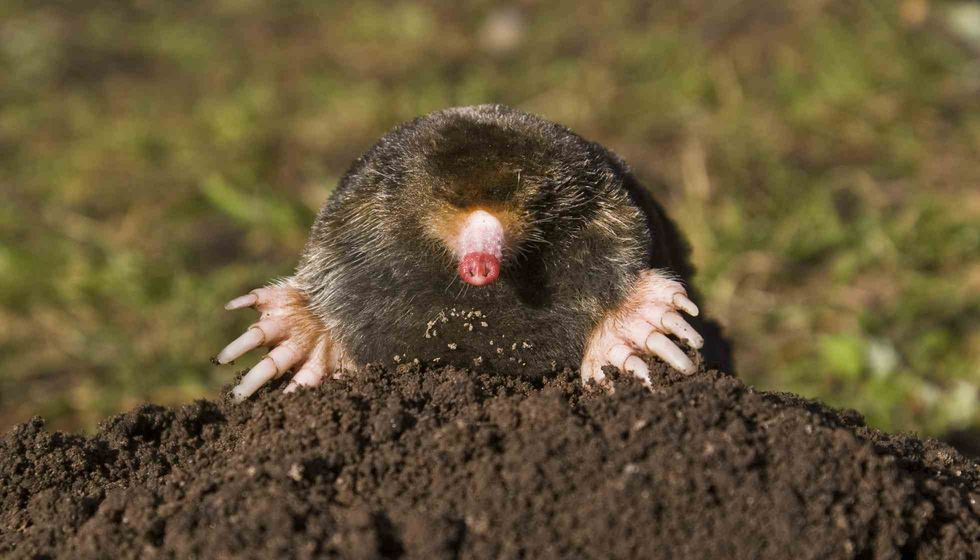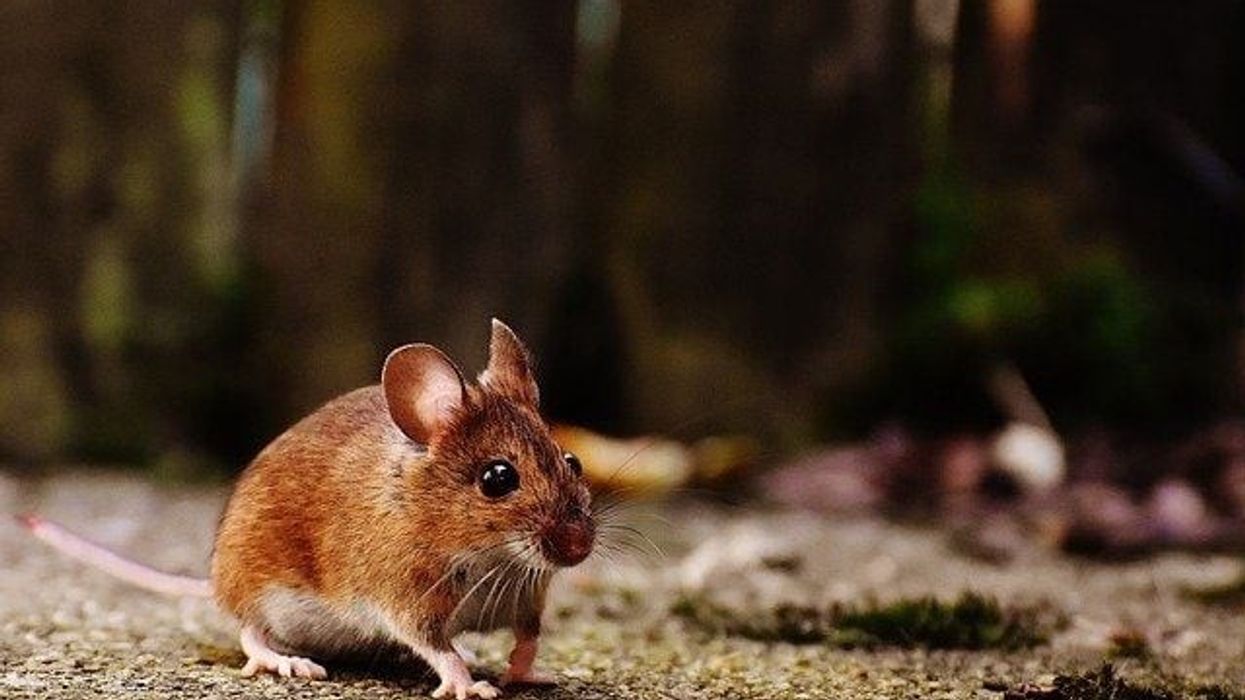There are various types of moles living in the world. Some of the popular ones are the star-nosed mole, the Eastern mole, and the American shrew mole.
Star-nosed moles are spectacular diggers and are semi-aquatic in nature, often digging their tunnels into the streams and lakes nearby and eating insects and worms like leeches and mollusks underneath the water. Eastern moles are seldom seen because they rarely come above ground. These are notorious moles who destroy golf courses and agricultural fields.
Moles are found all around the world especially in habitats like grasslands, gardens and urban areas, except in Antarctica and South America. Moles are rumored to be blind but that is not true.
They can see but have poor vision and an astounding sense of light and smell. They are not blind, despite the fact that they spend the majority of their time deep underneath the soil.
They dig an impressive series of tunnels and passages under soft, damp soil with their giant claws. It is because of the complex tunnel networks that they are often thought of as garden pests. These intricate underground labyrinths provide the mole with protective defense, shelter, and a place to call home.
Since moles are defenseless creatures against humans and predators, this is crucial to their existence. Their average lifespan is three years.
They are omnivores and feed mainly on earthworms along with worms, grubs, small spiders, and other insect larvae. They can store their prey to consume it later.
Read on to know more about their environment, diet, and other interesting facts.
Interesting Mole Facts
What type of animal is a Mole?
Moles are insectivorous animals found all over the world, except Antarctica and South America. Moles are small animals that have adapted to survive in self-dug tunnels deep underground. They are known for their pointy snouts and excellent digging skills.
What class of animal does a Mole belong to?
Moles belong to the class Mammalia.
How many Moles are there in the world?
Moles are quite common and have 20 'true mole' species all around the world. The total number of moles in the world is undefined.
Where does a Mole live?
Except for Antarctica and South America, moles can survive on any continent. They can be found in grasslands, urban areas, parks, sand dunes, or some other area with soil suitable for tunneling. However, as per The Young People's Trust for the Environment (YPTE), they prefer to avoid areas of mountainous terrain and acidic soil.
What is a Mole's habitat?
The main habitat of a mole is grasslands, parks, urban areas, lawns, or any soil that is suitable for digging. Floodplains, woodland, lakes, coastal dunes, cultivated areas, lowlands, and meadows are among the temperate habitats where moles thrive.
While there are certain species that are marine or semi-aquatic, they mostly prefer digging tunnels underground on the banks of ponds or streams. Many moles can swim well regardless of their environment.
Who do Moles live with?
The majority of moles live alone and only get together to reproduce. The star-nosed mole is the only species of mole known to live in colonies. A solitary mole's range might be as large as 2.7 acres (1.1 ha). A mole's underground habitat is made up of vast, complex burrow structures with separate dwelling and hunting sections.
How long does a Mole live?
The usual lifespan of a mole is three to four years in the wild.
How do they reproduce?
Males may expand their tunnel to cover more territory during the breeding season to seek females to mate with. Late in the winter, the mating season starts.
After the breeding is completed, a spherical-shaped nest chamber made of dry material of plant is built and the mother is largely left alone to raise the young without any assistance from the male.
A female mole gives birth to two to five baby moles after a 42-day gestation period. After about a month, baby moles are able to survive independently of their mothers.
What is their conservation status?
The mole family as a whole seems to be in good condition, according to conservation figures.
These animals are often classified as being of Least Concern on the IUCN (International Union for Conservation of Nature) Red List, which documents the survival status of various species. Although there are a few exceptions that are Endangered, such as Japan's Etigo mole and Russia's Russian desman, Spain's Vulnerable Pyrenean desman, and Japan's Near Threatened Sado mole.
It's hard to tell how many moles remain right now, but many populations seem to be stable, though some are declining.
Mole Fun Facts
What do Moles look like?

These stocky creatures have a pointed, hairless snout, narrow eyes, and no visible ears. Moles on average reach a length of 4.4-6.3 in (11.3-15.9 cm) from snout to rump.
The length of their tails ranges from 1-1.6 in (2.5-4 cm). They have a tiny, long, pink nose, along with a tiny tail, and two big 'hands' that look like shovels for front paws, both wrapped in black velvety fur.
It can burrow through the dirt very easily thanks to its huge paws, small arms, and long claws. These hands can also be used as swimming paddles.
How do they communicate?
Despite the fact that many mole animals have poor eyesight, they can distinguish light from dark and have good hearing despite the flaps over their ears. They communicate by sound, but smell and vibration can be the most important cues in mole communication.
How big is a Mole?
Adult moles are 4.4-6.25 in (11.3-15.9 cm) long. An adult fancy rat is almost twice the size of a mole at 9-11 in (22.9-27.9 cm).
How fast can a Mole run?
Although it cannot run fast above the ground (around 5 mph (8 kph)), moles have the ability to dig tunnels underground very fast at a speed of up to 15 ft per hour or 0.1 cm per second and dig 65 ft (19.8 m) in a day.
How much does a Mole weigh?
According to the Mammal Society, they weigh 2.5-4.5 oz (72-128 g).
What are their male and female names of the species?
A male mole is called a boar and a female mole is called a sow.
What would you call a baby Mole?
A baby mole is called a pup. At any given time, a female mole gives birth to three to four hairless pups.
The pups, or mole babies, begin to develop fur when they are two weeks old. The pups are weaned at four to five weeks and leave the nest at 33 days. Puppies abandon their mother and home tunnel entirely at the age of five or six weeks.
What do they eat?
The moles are so fond of earthworms that they consume almost their whole body weight in them each day. Apart from that, their diet also includes other insects, worms, grubs and tiny invertebrates.
Seeds, stems, roots of small plants, tubers, spores, and small mammals are added to its diet. Any amphibious moles can consume both fish and amphibians. The mole's saliva contains a poison that entraps prey, allowing it to store and digest the meat later.
Are they dangerous?
Humans are not harmed by moles. However, they are hazardous to the lawns and landscapes that they damage. When they dig their tunnels and forage for food, they can cause serious and expensive harm to the root systems of grasses and plants. They do not eat plant roots but only damage them.
Would they make a good pet?
Moles are animals who live in deep tunnel structures dug by their superior digging skills. Moles are not good pets and sometimes die easily in captivity, hence their widespread reputation as garden pests who damage farms and lawns.
Did you know...
A mole can squeeze a trapped earthworm between its forepaws before eating it to release the undesirable dirt from its stomach. Moles are among the only species that have the ability to sense in stereo.
This means they can sense odors and determine the direction from which they are traveling almost instantly. For moles, being able to smell in stereo is a huge advantage because it helps them to easily and reliably spot food and threats.
How many babies do moles have?
Three or four hairless babies are born at a time. The pups, or mole babies, begin to develop their skin at 14 days old. The pups are weaned at four to five weeks and leave the nest at 33 days.
Are moles blind?
No, contrary to popular belief, mole animal is not blind. It can see but has poor eyesight which gets overshadowed by its strong sense of vibration and smell. A notable characteristic is they can see light even if they have kept their eyes shut.
Here at Kidadl, we have carefully created lots of interesting family-friendly animal facts for everyone to discover! Learn more about some other mammals including field voles and kangaroo rats.
You can even occupy yourself at home by drawing one of our Mole coloring pages.










